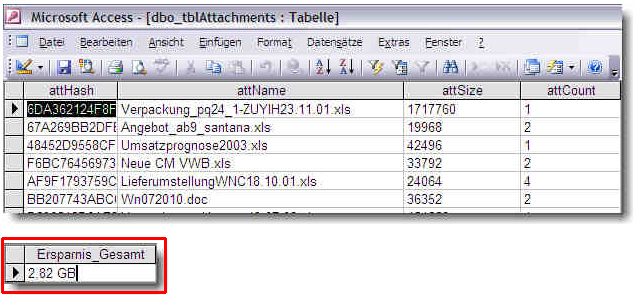S.I.S.C = Single Instance Space Calculator. Jo mei, wos ‘n des ??
S.I.S.C ist ein Instrument basierend auf Lotus Notes, MS SQL-Server und MS-Access zur Berechnung des Speicherverbrauchs redundanter Attachments.
Wozu braucht man das ?
Wir beschäftigen uns zur Zeit mit der Frage, wie viel Speicherplatz auf unseren NotesServern frei wird, wenn jedes Attachment nur noch ein einziges Mal vorhanden ist.
Im Moment sind ja die Attachments durch Mails an eine Gruppe oder mehrfache Weiterleitung oder Antwort n -fach in der Maildatei eines oder mehrerer User vorhanden.
Intelligente Systeme zur Auslagerung von Attachments oder Archivierung von Mails legen diese redundanten Attachments nur einmal ab und referenzieren jeweils auf diese “single instance” eines Attachments.
Die Fragen, die einem dabei im Kopf herumschwirren sind:
– Ist das mit der mehrfachen Speicherung wirklich sooooooooo dramatisch ? und
– wie zum Teufel soll ich das denn nun wieder so bauen, daÃ? es auch der oberste Oberindianer versteht ?
Herausgekommen ist S.I.S.C. Oberindianer interessieren sich wahrscheinlich nur für die rot eingerahmte Zahl.
SELECT Round ( Sum( Multiplikation.Ersparnis ) /1024000000,2 ) & " GB" AS Ersparnis_Gesamt
FROM Multiplikation;
Um die anfallenden Datenmengen zu handhaben, werkelt im Hintergrund ein SQL-Server. Bei kleineren Unternehmen kommt man wohl auch mit MS-Access als Datenspeicher aus. Ich benutze MS-Access der Einfachheit halber für die Auswertung der erfassten Daten.
Die Ermittlung der Daten erfolgt über Lotus Script in Verbindung mit einer für die Hashwertbestimmung entwickelten DLL.
Declare Function GetHash Lib "filehash" (_
Byval strFileName As String,_
Byval intAlgorithm As Integer,_
Byval intFormat As Integer,_
Byval intOperation As Integer,_
Byval intSHA2Strength As Integer)_
As String
'// Algorithm
Const CRC32 = 1
Const GOSTHASH = 2
Const MD2 = 3
Const MD4 = 4
Const MD5 = 5
Const SHA1 = 6
Const SHA2 = 7
'// Formatting options
Const LOWERCASE_NOSPACES = 1
Const LOWERCASE_SPACES = 2
Const UPPERCASE_NOSPACES = 3
Const UPPERCASE_SPACES = 4
'// SHA2_STRENGTH
Const SHA2_STRENGTH_128 = 128
Const SHA2_STRENGTH_256 = 256
Const SHA2_STRENGTH_512 = 512
'// Definitions of some kind
Const STRING_HASH = 1
Const FILE_HASH = 2
...
hash = GetHash (fNAME, SHA2, UPPERCASE_NOSPACES, FILE_HASH, SHA2_STRENGTH_128)
Die Daten werden bis auf ein paar statistische Daten zu den einzelnen Datenbanken anonym erfasst. Es sind keinerlei Rückschlüsse möglich, wer denn nun welches Attachment doppelt und dreifach in seiner Maildatenbank vohält. Datenschützer dürfen also aufatmen.
Ich werde an dieser Stelle weiter über die Entwicklung dieses Projekt berichten. Da das Know How möglicherweise für Consultants im Bereich DMS nützlich sein könnte, nehme ich Abstand davon, die relevanten Teile hier in allen Einzelheiten zu beschreiben und das Gesamtprojekt zum kostenlosen Download anzubieten.
Sollte Interesse bestehen, kann man jederzeit mit mir Kontakt per mail oder auch telefonisch aufnehmen.









